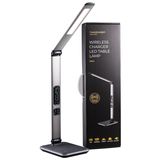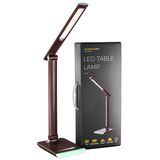THORGEON Table lamps






thorgeon table lamps optical and electrical profile
Outputs typically 400–900 lm at 2700/3000/3500/4000 K, CRI 90 options for colour-critical desks, efficacy 90–120 lm/W. Ripple is constrained to meet common PstLM/SVM guidance on approved controls. Integrated drivers target PF ≥0.90 and surge 1–2 kV; operating window −10…+35 °C with Tc marked on the head for audit. Weighted bases, anti-slip pads, and moulded strain-reliefs keep cords stable on busy worktops.
thorgeon desk lamps task optics and ergonomics
Three-axis heads and 300–700 mm reach set a 30–45° incidence on the work plane. Micro-prism or diffuser plates produce a 60–90° task field for 500 lx at 0.75 m with low veiling reflection. Rotary or touch dimming runs 5–100 % with memory start; tunable white 2700–5000 K is available for circadian policies. USB-A/USB-C power outlets remain galvanically isolated from the LED rail to avoid ripple coupling.
thorgeon led table lighting drivers and EMC
0–10 V and DALI options keep scene floors consistent across rooms; trailing-edge variants serve retrofit circuits. Conformal-coated PCBs tolerate humid housekeeping cycles; braided cords and ferruled terminations pass IP grommets cleanly. Shield terminations land 360° at gland plates when units hard-wire to furniture raceways.
thorgeon reading lamps close-range performance
Bedside and lounge pieces target 150–300 lm, 3000 K, CRI ≥90, and 30–40° beams to light pages without washing the room. Goosenecks hold position without drift; head-mounted switches enable one-hand operation. Ripple at 100/120 Hz is kept low to reduce eye fatigue during long sessions.
thorgeon portable table lights formats for FM teams
Clamp bases, weighted discs, and low-profile rails cover benches and narrow credenzas. Rechargeable variants use 18650/21700 packs with USB-C PD; docks with pogo pins suit housekeeping trolleys. IK07–IK09 impact ratings and IP54 housings survive routine moves between rooms.
thorgeon decorative table luminaires finishes and diffusion
Opal glass and fabric shades hide point sources; clear glass pairs with filament optics for sparkle. Metalwork comes in brushed aluminium or powder-coat RALs; felt pads protect stone and timber. Low-glare baffles limit luminance <1 500 cd/m² at 65° for comfortable peripheral views in lounges.
thorgeon indoor table fixtures integration and logistics
Inline switches sit 200–300 mm from the base; cords 1.5–2.0 m with moulded Euro/Schuko plugs. For concealed sockets, angled plugs reduce stress at skirting. Room-bundle kitting groups heads, shades, and collars by finish code; acceptance sheets record Tc, dim curve, cord set, and plug type.
Engineering notes installers actually use
- Electrical: 220–240 V AC; PF ≥0.90; surge 1–2 kV; inrush data available for relay planning on switched outlet boxes.
- Optical: CRI 80/90/95 by model; SDCM ≤3 colour stability; task beams 60–90°, reading beams 30–40°.
- Thermal: die-cast heads and graphite pads manage Tc; maintain 100–150 mm clearance above vented caps.
- Safety/standards: EN 60598-1/-2, LED modules to EN 62031, EMC EN 55015 with immunity EN 61547.
Deployment and selection remarks (keyword placements)
For desks that need 500 lx with tight glare control, estates shortlist thorgeon desk lamps by head geometry and diffuser type, then lock dimming behaviour for cloning across floors.
Hospitality teams specify thorgeon reading lamps with 3000 K and ≥90 CRI, tagging beam and finish so night swaps don’t alter ambience.
In open lounges, planners catalogue thorgeon led table lighting by lumen bin and control (0–10 V/DALI) to keep scenes coherent with ceiling controls.
Facilities standardise thorgeon portable table lights by battery format, dock type, and IK rating so kits rotate between rooms without adapters.
Designers pick thorgeon decorative table luminaires where visible shades demand uniform glow; logistics keep one finish code per zone to avoid mixed appearance.
For multi-brand furniture power, procurement indexes thorgeon indoor table fixtures by plug standard, cord length, and gland size so acceptance tests are unambiguous.
Office cores adopt thorgeon table lamps with CRI 95 at 3500–4000 K for video-friendly skin tones and low ripple in camera zones.
Advantages of working with Bankoflamps
We ship in the order crews place and power furniture. Quotes with EAN/MPN land in about an hour, and live EU stock is visible before teams are booked. Your portal shows lead times, shipment tracking, and downloadable price files with validity windows you can plan around. Trusted accounts use post-payment up to 30 days. We consolidate per room bundle so heads, shades, cords, and dim kits arrive together, and your account manager checks lumen bins, CCT/CRI, dim method, plug type, cord length, and Tc notes against your drawings—keeping table-lighting kits site-ready across France, the Baltics, Germany, Spain, Italy, Belgium, and the Netherlands.